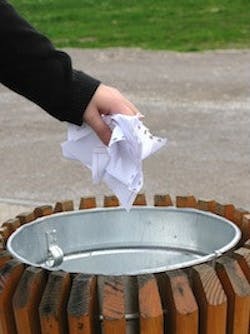San José Sets Record for Litter Removal in 2014
Guided by San José, Calif.’s commitment to keep trash out of local waterways and the bay, city staff, community groups and volunteers had a record-breaking year in 2014 for litter removal by picking up 163% more litter than in 2013.
More than 6,000 volunteers, participating at 115 cleanup events, collected 654 tons of litter from streets and creeks throughout San José—the equivalent to the volume of about 44 semi-trucks. The combined cleanups have had a dramatic impact on the quality of life and environment in the South Bay.
“I’m heartened by our community groups who are committed and working together to getting litter off our streets and out of creeks,” said Kerrie Romanow, director of San José Environmental Services Department (ESD). “I challenge everyone who lives, works, or visits San José to get involved – put trash where it belongs, pick up litter found on the street, and join community cleanups."
The amount of trash collected in 2014 is largely attributed to increased efforts by groups that partner with the city. A new community group—Restore Coyote Creek Project—mobilized hundreds of volunteers for cleanups, including residents and San Jose State University students.
“I’m amazed by our network of dedicated volunteers who are passionate about improving the health of the creek,” said Deb Kramer, Restore Coyote Creek project manager from the Santa Clara County Creeks Coalition. “Their enthusiasm to participate, ask questions, and be creative is contagious.”
In addition to community cleanup events, San José staff and volunteers also conduct annual cleanup activities at 32 creek “hotspot” litter locations since 2010. The results of these hotspot cleanups are regularly reported to the State Water Resources Control Board. The trash collected at 10 hotspot locations is sorted and categorized. In 2014, the most common items were paper, plastic and glass fragments, and food wrappers.
Plastic bags and foam containers are no longer at the top of this list since San José adopted its “Bring Your Own Bag” and Foam Food Ware ordinances, and plastic bag litter in creeks has been reduced by about 71%.
The cleanup events are coordinated by community groups that receive funding from ESD, San José Housing Department, and Santa Clara Valley Water District. Funding support has helped Friends of Coyote Creek, Friends of Los Gatos Creek/Guadalupe River, Restore Coyote Creek Project, Creek Connections Action Group, Downtown Streets Team, and the city’s own Anti-Litter Program in the Parks, Recreation and Neighborhood Services Department.
Litter cleanup efforts in San José will increase in the coming years as part of the cty’s long-term litter reduction plan. The annual Great American Litter Pickup will take place in multiple locations throughout San José on April 25, 2015.
Litter easily flows down gutters and pavement into storm drains by rain or irrigation runoff, and what goes down a storm drain usually winds up in the nearest creek leading to the Bay. Litter and pollutants harm creek habitat, and can continue to cause environmental damage as they move through the bay to the Pacific Ocean.
In 2009, the State Water Resources Control Board required all Bay Area cities and storm water agencies to develop actions to reduce litter from storm sewer systems by 40% by 2014, 70% by 2017, and 100% by 2022.
Source: City of San Jose
